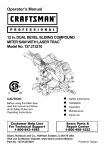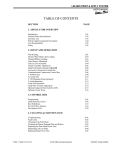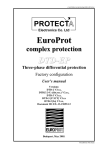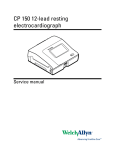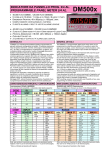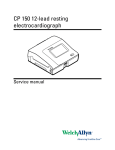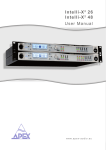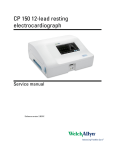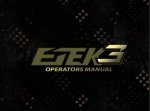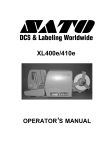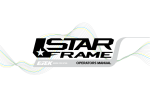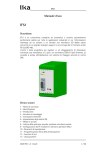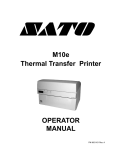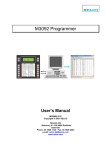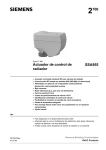Download LM3510 Manual
Transcript
LM-3501 PRINT & APPLY SYSTEM USER’S MANUAL TABLE OF CONTENTS SECTION PAGE 1. APPLICATOR OVERVIEW Introduction General Printer Specifications Inventory List Print & Apply Component Description User Responsibility Safety 1-01 1-02 1-03 1-04 1-05 1-05 2. SETUP AND OPERATION Web Routing Thermal Print Head Label Loading Thermal Ribbon Loading Label Sensor Adjustment Take Up Unit Assembly Clutch Assembly Adjustment Operator Interface Terminal Accessory Connector Panel T-50 Photo Eye Air assist tube T-150 Mounting Stand (optional) T-stand adjustment Tamp Unit Operation Tamp Flow Control Adjustment Optional Adjacent Panel Labeler (APL) Optional Corner Wrap 2-01 2-03 2-03 2-03 2-04 2-05 2-06 2-07 2-07.5 2-08 2-09 2-10 2-11 2-12 2-13 2-14 3. CONTROL BOX Programming Quick Reference Chart Key Definitions Set Up Of Key Features Description of I/O 3-01 3-05 3-15 3-16 3-20 4. CLEANING & MAINTENANCE Troubleshooting Fault Codes Cleaning of the Print Head Cleaning the Platen, Demand Plate and Rollers Replacing the Print Head Power Fuse Maintaining The Air Slide Replacing Main Power Fuse Page 1 Made in the U.S.A. © 2003 MMI Automated Systems 4-01 4-02 4-03 4-03 4-03 4-04 4-05 12/23/03 Model LM-3501 LM-3501 PRINT & APPLY SYSTEM USERS MANUAL SECTION 1 APPLICATOR OVERVIEW Introduction General Printer Specifications Inventory List Print & Apply Component Description User Responsibility Safety Page 2 Made in the U.S.A. © 2003 MMI Automated Systems 1-01 1-02 1-03 1-04 1-05 1-05 12/23/03 Model LM-3501 LM-3501 PRINT & APPLY SYSTEM USER’S MANUAL LABEL MILL 3501 THERMAL PRINTER/APPLICATOR SYSTEM INTRODUCTION The Label-Mill 3501 is a state of the art THERMAL PRINTER & APPLICATOR SYSTEM created with maximum flexibility for your AUTOMATIC LABELING NEEDS. The unit will print and apply high quality labels and bar codes to your product at print speeds up to 10”/sec. and apply at speeds up to 80 labels/min. OPERATION The standard configuration is External Computer Mode. The configuration allows label formats to be sent to the standard Centronics Parallel Interface Port, or serial port, on the Printer/Applicator. Once the format is downloaded to the Printer Job Buffer, the system 3501 can print and apply as normal. Standard industry label software packages can be used in conjunction with a PC to design and load label design. 1-01 Page 3 Made in the U.S.A. © 2003 MMI Automated Systems 12/23/03 Model LM-3501 LM-3501 PRINT & APPLY SYSTEM USERS MANUAL SPECIFICATIONS PRINT SPEED Up to 10”/second and approx. 80 labels/min. (Varies depending on label and product size.) BAR CODES UPC-A, UPC-E, EAN-8,EAN-13, Code 39, Int. 2 of 5, Code 128, MSI 2 of 5, UPC Bookland, and CODABAR. BAR CODE RATIOS 1:2, 1:2.5, 1:3 or individually programmable bar code widths HUMAN READABLE FONTS Eight fonts including OCR-A and OCR-B representation and an outline font. American and European fonts. Upper case and lower case with decendors plus memory available for custom fonts. LABEL ROLL CAPACITY 12” Max. outside diameter wound on a 3” diameter core. Die cut waste removed with a minimum of 1/8” separation between labels in running direction. LABEL SIZE Minimum: 1” wide x ¾” long Maximum: 7.2” wide x 14” long MAXIMUM PRINT AREA 6.5” wide x 14” long LABEL PLACEMENT ACCURACY Up to + or - 1/32” (1mm) when labels are produced to specifications and product handling is controlled. PRINTING METHOD Thermal Transfer and Direct Thermal Print application method…Standard Tamp, Optional Blow On and Wipe On. INTERFACE Standard Centronics Parallel Port Standard RS-232C Serial Port INTERFACE SENSORS Ribbon out Product Sensor-Photo Eye-Limit Switch PLC input ELECTRICAL 115V AC/60 Hz-250 W idle, 600 W running. AIR REQUIREMENT 80 p.s.i./3 cfm SIZE 21” W x 28-1/4” L x 23-3/8” D ENVIRONMENT Operating Temp. 50-95 F (10-35 C) 15-85% RH. non-condensing WEIGHT 60 lb. (with U-Arms) *Options available 1-02 Page 4 Made in the U.S.A. © 2003 MMI Automated Systems 12/23/03 Model LM-3501 LM-3501 PRINT & APPLY SYSTEM USER’S MANUAL INVENTORY LIST QTY. 1 2 1 2 1 1 1 1 1 1 Description Print & Apply Assembly 12-½” dia. Blue Plastic Spools w / Quick Release Collar 7-¾” dia. Blue Plastic Spool w / screws ½” - 13 bolts w / washers Power Cord Model 3500 Operators Manual Extra Cardboard Ribbon Core Product Switch (specified) a. Manual Limit Switch (optional) b. Photo Switch (optional) Take-up Spool Clip Head Cleaning Kit (optional) Part No. SA070 TOOLS REQUIRED FOR ASSEMBLY : 3/32” ALLEN WRENCH ¾” WRENCH 1-1/8” WRENCH 1-03 Page 5 Made in the U.S.A. © 2003 MMI Automated Systems 12/23/03 Model LM-3501 LM-3501 PRINT & APPLY SYSTEM USERS MANUAL COMPONENT DESCRIPTION LABEL SPOOL TAMP CYLINDER SPOOL LOCK U-ARM THERMAL PRINTER WEB GUIDE ROLLERS WEB TAKE-UP SPOOL 1-04 Page 6 Made in the U.S.A. © 2003 MMI Automated Systems 12/23/03 Model LM-3501 LM-3501 PRINT & APPLY SYSTEM USER’S MANUAL USER RESPONSIBILITY This equipment will perform in conformity with the description thereof contained in this manual and accompanying labels and / or inserts when installed, operated, maintained, and repaired in accordance with the instructions provided. This equipment must be checked periodically. Defective equipment should not be used. Parts that are broken, missing, plainly worn, distorted, or contaminated should be replaced immediately. Should such repair or replacement become necessary, we recommend that a request for service advice be made. This equipment or any of its parts should not be altered without the prior written approval of MMI Automated Systems. The user of this equipment shall have the sole responsibility for any malfunctions which results from improper use, faulty maintenance, damage, improper repair or alteration by anyone other than MMI Automated Systems or a service facility designated by MMI Automated Systems. SAFETY Only qualified personnel should use this equipment. Before installing, inspecting or servicing equipment, turn OFF all power and air controls at the source and lock out in accordance with OSHA Standards. Be sure all external electrically conductive parts are connected to a good electrical ground. Never handle live electrical equipment with bare hands while standing in water, or while hands and feet are wet. Dangerous electrical shock can result. Whenever the equipment is unattended, turn off all control and power supply switches. Keep equipment clean and in good operating condition. Promptly repair or replace all worn or damaged hoses, cables or parts. Do not make any repairs to equipment unless you are fully qualified. This equipment contains fast moving parts, which may move without warning. Keep hands, loose hair and clothes clear of machines at all times. Never place hands or any other body parts under the label platen at any time. This equipment uses compressed air. Proper care and maintenance must be taken when handling compressed air and its components. These precautions are further detailed and explained where specifically required in this manual. ! WARNING READ AND UNDERSTAND THESE INSTRUCTIONS Protect yourself and others. Be sure this information is read and understood by all operators. ELECTRICAL SHOCK CAN KILL! Do not touch live electrical parts with bare skin or work with gloves or wet clothing. NOISE CAN DAMAGE HEARING! Wear proper ear protection. 1-05 Page 7 Made in the U.S.A. © 2003 MMI Automated Systems 12/23/03 Model LM-3501 LM-3501 PRINT & APPLY SYSTEM USERS MANUAL SECTION 2 SETUP AND OPERATION Web Routing Thermal Print Head Label Loading Thermal Ribbon Loading Label Sensor Adjustment Take Up Unit Assembly Clutch Assembly Adjustment Operator Interface Terminal Accessory Connector Panel T-50 Photo Eye Air Assist Tube T-150 Mounting Stand (option) T-stand adjustment Tamp Unit Operation Tamp Flow Control Adjustment Optional Adjacent Panel Labeler (APL) Optional Corner Wrap Page 8 Made in the U.S.A. © 2003 MMI Automated Systems 2-01 2-03 2-03 2-03 2-04 2-05 2-06 2-07 2-07.5 2-08 2-09 2-10 2-11 2-12 2-13 2-14 12/23/03 Model LM-3501 LM-3501 PRINT & APPLY SYSTEM USER’S MANUAL WEB ROUTING Step Operation 1 Load web onto label storage spool (A) so it unloads in a clockwise direction. (refer to pg. 2-2) Feed the web to the left and below roller guide (B), to the right of roller (C) and to the left and below roller guide (D). Feed the web into the thermal printer. (for a detailed description of thermal printer routing see page 2-3) Finish the process by loading the waste backing paper onto the web take up spool (E). The take up spool rotates in a clockwise direction. Adjust the (2) plastic web guide clips so the web is guided straight and even. Make sure clips do not bind the web. 2 3 4 5 *For a detailed illustration of this procedure, see Figure 2-1 below. FIGURE 2-1 /$ (/ 0 // , % @ , 00 $ < 7 20$ 7 ( ' 6 6 (0 @ (B) % 6 7 0) * (A) (C) (E) (D) 2-01 Page 9 Made in the U.S.A. © 2003 MMI Automated Systems 12/23/03 Model LM-3501 LM-3501 PRINT & APPLY SYSTEM USERS MANUAL WEB ROUTING SPOOL LOCK 6 0 ( 7 6 (A) 0 ) * @ 6 '( 7 00 $0 2 7 < $ , % @ (C) (B) (E) (D) SPOOL LOCK SPOOL LOCK REMOVAL: To remove the label storage spool (A), turn the spool lock counterclockwise until you reach a stop. The spool will now slide off. To secure the spool, simply turn the spool lock clockwise until snug. DO NOT over tighten! 2-02 Page 10 Made in the U.S.A. © 2003 MMI Automated Systems 12/23/03 Model LM-3501 LM-3501 PRINT & APPLY SYSTEM USER’S MANUAL LOADING THERMAL PRINT HEAD REFER TO PRINTER MANUAL LABEL & RIBBON ROUTING REFER TO PRINTER MANUAL THERMAL RIBBON LOADING REFER TO PRINTER MANUAL NOTE: The printer will not operate unless the front cover is in the fully closed position. For your continued safety, do not override the front cover interlock switch. LABEL SENSOR ADJUSTMENT REFER TO PRINTER MANUAL 2-03 Page 11 Made in the U.S.A. © 2003 MMI Automated Systems 12/23/03 Model LM-3501 LM-3501 PRINT & APPLY SYSTEM USERS MANUAL TAKE-UP UNIT ASSEMBLY The Take-Up Assembly is located on the backside of the main panel. To adjust the clutch, the side panels must be removed to gain access. To remove the Clutch Assembly, you must first remove the Web Take-Up Spool. The mounting bolts for the Take-Up Assembly can be found directly behind the plastic spool. WARNING!!! Be sure power is off before performing any service. TAKE-UP ASSEMBLY 2-04 Page 12 Made in the U.S.A. © 2003 MMI Automated Systems 12/23/03 Model LM-3501 LM-3501 PRINT & APPLY SYSTEM USER’S MANUAL CLUTCH ADJUSTMENT (A) (B) (C) (D) (E) (F) (G) (H) DRIVE DOG SHAFT WHEEL FRICTION DISC PRESSURE PLATE THRUST BEARING PRESSURE SPRING TENSION ADJ. COLLAR SHAFT LOCK COLLAR To increase waste web tension, move the Tension Adjustment Collar (G) 1/32” toward the motor. To reduce web tension, move the Tension Adjustment Collar (G) 1/32” toward the spool. CAUTION…Too much web tension may cause web breakage, print drifting, or premature failure of the TakeUp Assembly. . 2-05 Page 13 Made in the U.S.A. © 2003 MMI Automated Systems 12/23/03 Model LM-3501 LM-3501 PRINT & APPLY SYSTEM USERS MANUAL OPERATOR INTERFACE TERMINAL LCD OPERATOR INTERFAC MAIN POWER 2-06 Page 14 Made in the U.S.A. © 2003 MMI Automated Systems 12/23/03 Model LM-3501 LM-3501 PRINT & APPLY SYSTEM USER’S MANUAL ACCESSORY CONNECTOR LOCATED ON THE REAR PANEL OF THE OPERATOR INTERFACE TERMINAL 2-07 Page 15 Made in the U.S.A. © 2003 MMI Automated Systems 12/23/03 Model LM-3501 LM-3501 PRINT & APPLY SYSTEM USERS MANUAL T-50 PHOTO EYE 2-07.5 Page 16 Made in the U.S.A. © 2003 MMI Automated Systems 12/23/03 Model LM-3501 LM-3501 PRINT & APPLY SYSTEM USER’S MANUAL AIR ASSIST TUBE The Air Assist Tube must be adjusted to clear the trailing edge of the printed labels and the Label Platen. An adjustment screw is used to adjust the position of the air holes in relation to the labels. An angle of 45 degrees is required. One slot is provided to make the appropriate adjustments desired. . Label Platen Air Assist Tube Airflow Blow tube mounting bracket Adjustment screw Clamp screw 2-08 Page 17 Made in the U.S.A. © 2003 MMI Automated Systems 12/23/03 Model LM-3501 LM-3501 PRINT & APPLY SYSTEM USERS MANUAL OPTIONAL T-150 MOUNTING STAND 2-09 Page 18 Made in the U.S.A. © 2003 MMI Automated Systems 12/23/03 Model LM-3501 LM-3501 PRINT & APPLY SYSTEM USER’S MANUAL T-STAND ADJUSTMENT Column Crank Control Mounting Arm Column Lock 2-10 Page 19 Made in the U.S.A. © 2003 MMI Automated Systems 12/23/03 Model LM-3501 LM-3501 PRINT & APPLY SYSTEM USERS MANUAL TAMP UNIT OPERATION • Tamp Duration Tamp duration is used to provide an on timer for the solenoid valve on the main tamp cylinder. The delay on standard versions can be from 0 to 30.000 seconds in 1/1000 of a second accuracy. This allows for easy change over from one product height to another without physically changing the height of the unit. It also allows for precise adjustments of how close the tamp head comes to the product. (refer to page 3-08) There is flow control adjustment for the valves. It may be necessary to adjust the flow rate on the tamp solenoid for optimum performance after installation. The adjustment is performed as shown below. They are set at the factory. The regulators on the vacuum, air assist, and flag valves are for increasing or decreasing the air pressure as necessary for proper operation. Note: Flag Regulator not shown below – only supplied with flag applicators. Vacuum Pump Flow Control (B) Flow Control (A) Vacuum regulator Air assist regulator 2-11 Page 20 Made in the U.S.A. © 2003 MMI Automated Systems 12/23/03 Model LM-3501 LM-3501 PRINT & APPLY SYSTEM USER’S MANUAL TAMP FLOW CONTROL ADJUSTMENT Regulator Adjustment: Clockwise - Increase pressure Counterclockwise - Decrease pressure MAIN AIR REGULATOR Controls maximum air pressure available to entire applicator. Should be set between 40 and 80 PSI. FLAG REGULATOR The flag regulator is used to adjust the pressure that the flag jaws apply to the label as it is applied. VACUUM REGULATOR (only used on the flag and tamp applicator system) The vacuum regulator is used to control the vacuum that is used to hold the label to the flag jaws or the tamp pad. AIR ASSIST REGULATOR The air assist regulator is used to change the pressure that is applied to the blow tube. The blow tube is below the front edge of the peeler plate and is used to help “push” the label onto the bottom of the tamp pad or the flag jaws. FLOW CONTROLS (tamp and flag applications) Control A: This is used to adjust the pressure that controls the tamp cylinder in the upward direction. Control B: Controls the tamp cylinder in the downward direction. Page 21 Made in the U.S.A. © 2003 MMI Automated Systems 12/23/03 Model LM-3501 LM-3501 PRINT & APPLY SYSTEM USERS MANUAL 2-12 Page 22 Made in the U.S.A. © 2003 MMI Automated Systems 12/23/03 Model LM-3501 LM-3501 PRINT & APPLY SYSTEM USER’S MANUAL OPTIONAL ADJACENT PANEL LABELER (APL) 2-13 Page 23 Made in the U.S.A. © 2003 MMI Automated Systems 12/23/03 Model LM-3501 LM-3501 PRINT & APPLY SYSTEM USERS MANUAL OPTIONAL CORNER WRAP 2-14 Page 24 Made in the U.S.A. © 2003 MMI Automated Systems 12/23/03 Model LM-3501 LM-3501 PRINT & APPLY SYSTEM USER’S MANUAL OPTIONAL SIDEWINDER 2-15 Page 25 Made in the U.S.A. © 2003 MMI Automated Systems 12/23/03 Model LM-3501 LM-3501 PRINT & APPLY SYSTEM USERS MANUAL SECTION 3 CONTROL BOX Programming Quick Reference Chart Key Definitions Set Up of Key Features & Quick Start Description of I/O Page 26 Made in the U.S.A. © 2003 MMI Automated Systems 3-01 3-05 3-15 3-16 3-21 12/23/03 Model LM-3501 LM-3501 PRINT & APPLY SYSTEM USER’S MANUAL PROGRAMMING All programming is performed via the keypad and display as shown on page 2-6. All programmed settings are battery backed in nonvolatile memory and are not lost when the unit is powered off. Upon power up of the control, the screen will display MODEL NUMBER & REVISION. After this, the screen will now display INITIALIZING. The final screen in the wake-up will display the counter, TOTAL XXXXXX BATCH XXXXXX. • KEY FUNCTIONS: UP - DOWN ARROW KEYS ARE USED TO: 1. 2. 3. 4. Scroll up & down through the primary menu “PROGRAM BLOCKS” (Header name) Scroll sub menus inside of “PROGRAM BLOCKS” (top line of display while IN a “PROGRAM BLOCKS”) Scroll data selection / options (bottom line of display after entering the selected “PROGRAM BLOCKS”) Select different display views while in the “RUN” mode. “ENT” ENTER KEY IS USED TO: 1. Access or “Enter” the selected “PROGRAM BLOCK” (example PRODUCT SENSOR or TAMP SETUP) 2. Access or “Enter” the data selection / options line (bottom line of display) of the “PROGRAM BLOCK” Sub Menus 3. Store the selected data and return to the Sub Menu of the “PROGRAM BLOCK” (top line of display) Note that the carrot (>), on the left-hand side of the display, will move line to line (up / down) to indicate what line you are currently in. “PROG” PROGRAM KEY IS USED TO: 1. 2. 3. 4. Enter Main program menu Exit primary and secondary menus Back out of the program menu one block at a time until you completely exit the program menu. Exit a primary or secondary menu WITHOUT changing the data. (PROG key will not SAVE changes) START KEY: Start key will initialize the application cycle. STOP/CLEAR KEY: 1. Stop key will abort the cycle only when not in the program menu and disable the system. The system will be enabled only after the key is pressed again. 2. Clear key will delete stored values while in the edit mode. HOT KEY: The Hot Key is used while in the primary program block to fast forward to the desired program block. The number located in the upper left-hand corner of the primary Program Block (0-9) identifies the Hot Key. For example, by depressing the “4” key you will automatically advance to the Program Block “Counters”. 3-01 Page 27 Made in the U.S.A. © 2003 MMI Automated Systems 12/23/03 Model LM-3501 LM-3501 PRINT & APPLY SYSTEM USERS MANUAL • PASS NUMBER The PASS NUMBER is used to lock the menus of the control at (4) different levels. This option is used to prevent unauthorized access to variable data. When shipped from the factory, the pass number is set to 0000 and NO MENUS are locked. If a different pass number is entered, this number MUST BE MEMORIZED to be able to access the settings in the controller at a later time. • #1 PRODUCT SENSOR This is an external device that when “activated” starts the application cycle. PROGRAMMABLE BLOCKS: Product Delay - delays the application of the label (x) seconds after the sensor has been activated ** Sensor Type - used to designate the type of product sensor used, Normally open is the standard Sensor Trigger - designates whether the product sensor is activated at the leading or trailing edge of the product. Multiple Feed - how many labels are applied to one product with one signal (reset when signal is toggled) Interval Delay - amount of time in seconds between multiple fed labels Note: only active if quantity 2 or higher ** Note the product delay feature will not work when the “Conveyor Lock” feature is activated, use TRIGGER DISTANCE. • #2 TAMP SET UP This is used to adjust the different variables related to the tamp cycle. PROGRAMMABLE BLOCKS: Tamp duration - used to adjust the time that the tamp cylinder valve is actuated. (00.000 to 30.000) Flag duration - used to adjust the time the flag jaws are held open after label application.(00.00 to 99.99) Head up limit switch – type: normally open-standard, normally closed, none Head up Dbounce – Debounce is used to allow time for the tamp cylinder to settle on return. (00.00 to 01.00) Vacuum Release – Used to release label when tamping on light products. Vacuum Delay On – Used to reduce label flutter when feeding large labels while tamping. Tamp Sync Logic – Used to interface external equipment in relationship to the tamp cycle. Air Assist DLY - Used to delay the air assist from turning off after feeding the label. (00.00 to 01.00) • #3 TAKEUP This is used to delay the start and stop of the take up motor. PROGRAMMABLE BLOCKS: Start delay – delays (x) seconds after start print before starting take up motor. Stop delay – take up runs (x) seconds after end print signal is received from printer. Jog take up – press the ENT key to jog the take up motor. Note: If acceleration is set too low (Quick) following errors may occur. 3-02 Page 28 Made in the U.S.A. © 2003 MMI Automated Systems 12/23/03 Model LM-3501 LM-3501 PRINT & APPLY SYSTEM USER’S MANUAL • #4 COUNTERS Used to reset and set the internal counters of the control. PROGRAMMABLE BLOCKS: Total counter - resets the total counter to zero. Batch counter - resets the batch counter to zero. Batch counter set - sets the total number of labels to be applied in 1 batch. Life counter - displays the total number of controller cycles, can not be reset. (Note that when the batch counter expires the batch done output is activated.) • #5 PRINT TYPE The print type command is used to activate the print repeat cycle in the supplied print engine (Sato only). This feature will continue to print the last label in the buffer after the buffer count has expired. PROGRAMMABLE BLOCKS: Print Repeat– turn repeat print option ON or OFF • #6 ENCODER Provides a more consistent way to apply labels to a product. With this option a distance from the trigger point can be set at which the label is to be applied. Note: optional encoder must be used with this feature. PROGRAMMABLE BLOCKS: Encoder - used to turn the encoder option on or off. Enc Override – Allows fine-tuning of the ratio of applicator speed to conveyor speed. Trigger Distance - used to apply the label a certain distance away from the trigger point. Start Comp Dist – Start Compensation Distance used to compensate for variable speed applications. Enc lines/inch - tells how many pulses the encoder will count with 1 inch of travel. (25 to 500 counts per inch) 3-03 Page 29 Made in the U.S.A. © 2003 MMI Automated Systems 12/23/03 Model LM-3501 LM-3501 PRINT & APPLY SYSTEM USERS MANUAL • #7 CYCLE TYPE Determines the application type and sequence in relation to the label. PROGRAMMABLE BLOCKS: Tamp cycle type - Before feed (standard), after feed, No tamp, changes tamp cycle in relation to label feeding. Blow label - turns the blow on option on or off. Note: In the “BLOW mode” a tamp cycle must also be enabled and a tamp duration entered (program block #2 TAMP). Variable data - on or off, When turned on the preprint port is activated, this allows a optional product trigger to print the label, the second (standard) trigger would activate the tamp cycle only. This is used primarily with variable data being gathered for example when the applicator is being interfaced with a scale. • #8 NOT SUPPORTED • #9 JOB STORAGE Used to store frequently used settings pertaining to different labeling jobs. PROGRAMMABLE BLOCKS: Job store - stores settings for last job. Job select - allows operator to select 1 of the optional 10 stored jobs. Job delete - allows operator to delete a stored job. • DEFAULT SETTINGS This setting will return the controller to the default settings. • I/O STATUS Displays the status of the inputs and outputs. Page 30 Made in the U.S.A. © 2003 MMI Automated Systems 12/23/03 Model LM-3501 LM-3501 PRINT & APPLY SYSTEM USER’S MANUAL 3-04 Page 31 Made in the U.S.A. © 2003 MMI Automated Systems 12/23/03 Model LM-3501 LM-3501 PRINT & APPLY SYSTEM USERS MANUAL QUICK PROGRAMMING CHART MODEL NUMBER & REVISION LM MODEL 1501 INITIALIZING UP AND DOWN ARROW KEYS WILL SCROLL THROUGH THE PROGRAM BLOCKS AND THE SUB MENUS TOTAL 000000 BATCH 000000 PRESS "PROG" KEY PASS NUMBER PRESS "ENTER" #1 PRODUCT SENSOR PRESS "ENTER" #2 TAMP SET UP PRESS "ENTER" #3 TAKEUP PRESS "ENTER" 3-05 Page 32 Made in the U.S.A. © 2003 MMI Automated Systems 12/23/03 Model LM-3501 LM-3501 PRINT & APPLY SYSTEM USER’S MANUAL #4 COUNTERS PRESS "ENTER" #5 PRINT TYPE PRESS "ENTER" #6 ENCODER PRESS "ENTER" #7 CYCLE TYPE PRESS "ENTER" #8 NOT SUPPORTED PRESS "ENTER" #9 JOB STORAGE PRESS "ENTER" DEFAULT SETTINGS PRESS "ENTER" I/O STATUS PRESS "ENTER" PRESS "PROG" KEY 3-06 Page 33 Made in the U.S.A. © 2003 MMI Automated Systems 12/23/03 Model LM-3501 LM-3501 PRINT & APPLY SYSTEM USERS MANUAL MAIN DISPLAYS PASS NUMBER PRESS "ENTER" >LOCK WHAT MENUS 23456789 >ENTER PASS # 0000 >CHANGE PASS # NO CHANGE PASS # >YES 0000 >LOCK WHAT MENUS ALL >LOCK WHAT MENUS 5678 Note: When a pass number is used, all menus not numbered are automatically locked, as well as the selected locked menus. 3-07 Page 34 Made in the U.S.A. © 2003 MMI Automated Systems 12/23/03 Model LM-3501 LM-3501 PRINT & APPLY SYSTEM USER’S MANUAL #1 PRODUCT SENSOR PRESS "ENTER" SENSOR TYPE >DISABLED >PRODUCT DELAY 00.000 SECONDS >SENSOR TYPE NORMALLY OPEN SENSOR TYPE >NORMALLY CLOSED >SENSOR TRIGGER LEADING EDGE SENSOR TRIGGER >TRAILING EDGE >ON DEBOUNCE 00.000 USED TO FILTER FAULSE TRIGGERING >OFF DEBOUNCE 00.000 USED TO FILTER FAULSE TRIGGERING >MULTIPLE FEED QUANTITY # 01 MULTIPLE FEED >QUANTITY # 02 Range 01-10 ONLY ACTIVE #02 OR LARGER >INTERVAL DELAY 00.00 SECONDS 3-08 Page 35 Made in the U.S.A. © 2003 MMI Automated Systems 12/23/03 Model LM-3501 LM-3501 PRINT & APPLY SYSTEM USERS MANUAL #2 TAMP SETUP PRESS "ENTER" >TAMP DURATION 00.000 SECONDS >FLAG DURATION 00.00 SECONDS HEAD UP SWITCH >NORMALLY OPEN >HEAD UP SWITCH NORMALLY CLOSED HEAD UP SWITCH >NO TAMP SWITCH >HEAD UP DBOUNCE 00.00 >VACUUM RELEASE 00.00 Note this time can never be larger then the tamp duration >VACUUM DELAY ON 00.00 TAMP SYNC LOGIC >NORMAL TAMP SYNC LOGIC >REVERSE AIR ASSIST DLY >00.00 3-09 Page 36 Made in the U.S.A. © 2003 MMI Automated Systems 12/23/03 Model LM-3501 LM-3501 PRINT & APPLY SYSTEM USER’S MANUAL #3 TAKEUP PRESS "ENTER" >START DELAY .000 STOP DELAY >.000 JOG TAKE UP >ENTER TO JOG #4 COUNTERS PRESS "ENTER" >TOTAL CNT RESET PRESS "ENTER" ARE YOU SURE? YES, PUSH "ENTER" >BATCH CNT. RESET PRESS "ENTER" ARE YOU SURE? YES, PUSH "ENTER" >BATCH PRESET SET 0000000 >LIFE COUNTER 0000000 3-10 Page 37 Made in the U.S.A. © 2003 MMI Automated Systems 12/23/03 Model LM-3501 LM-3501 PRINT & APPLY SYSTEM USERS MANUAL #5 PRINT TYPE PRESS "ENTER" >PRINT REPEAT OFF PRINT REPEAT >OFF #6 ENCODER PRESS "ENTER" >ENCODER ON >ENC OVERRIDE % 150.0 ENCODER >OFF Range 50-150% >TRIGGER DISTANCE 00.00 START COMP DIST 0.000 RANGE 0 - 5.000 ENC LINES/INCH 0025.0 RANGE 25-500 3-11 Page 38 Made in the U.S.A. © 2003 MMI Automated Systems 12/23/03 Model LM-3501 LM-3501 PRINT & APPLY SYSTEM USER’S MANUAL #7 CYCLE TYPE PRESS "ENTER" TAMP CYCLE TYPE NO TAMP >TAMP CYCLE TYPE BEFORE FEED TAMP CYCLE TYPE >AFTER FEED >BLOW LABEL OFF BLOW LABEL >ON >VARIABLE DATA OFF VARIABLE DATA >ON #8 NOT SUPPORTED PRESS "ENTER" 3-12 Page 39 Made in the U.S.A. © 2003 MMI Automated Systems 12/23/03 Model LM-3501 LM-3501 PRINT & APPLY SYSTEM USERS MANUAL #9 JOB STORAGE PRESS "ENTER" >JOB STORE PRESS "ENTER" >JOB SELECT PRESS "ENTER" >JOB DELETE PRESS "ENTER" >STORE CURRENT 00 1-10 >SELECT JOB FROM 00 DELETE JOB >00 Range 01-10 Jobs Range 01-10 Jobs ENTER: OVERWRITE CLEAR: ABORT ARE YOU SURE? YES, PUSH "ENTER" DELETE THE JOB? YES, PRESS "ENTER" ARE YOU SURE? YES, PUSH "ENTER" THE JOB SELECTED IS EMPTY SELECT JOB FROM RANGE 1-10 DEFAULT SETTINGS PRESS "ENTER" SET DEFAULTS CLEAR: 5 SECONDS 3-13 Page 40 Made in the U.S.A. © 2003 MMI Automated Systems 12/23/03 Model LM-3501 LM-3501 PRINT & APPLY SYSTEM USER’S MANUAL I/O STATUS PRESS "ENTER" >I/O STATUS STATUS PANEL I/O STATUS >STATUS PANEL DISPLAY I/O PRESS "ENTER" I/O STATUS >PORT X0 PORT X0 0 0 0 0 0 0 0 0 X P SI Y A F V T 0 0 0 0 0 0 0 0 I/O STATUS >PORT X1 PORT X1 0 0 0 0 0 0 0 0 I/O STATUS >PORT X2 PORT X2 0 0 0 0 0 0 0 0 I/O STATUS >PORT Y0 PORT Y0 0 0 0 0 0 0 0 0 I/O STATUS >PORT Y1 PORT Y1 0 0 0 0 0 0 0 0 I/O STATUS >PORT Y2 PORT Y2 0 0 0 0 0 0 0 0 I/O Ports are numbered as follows 76543210 Ports are numbered from right to left. 3-14 Page 41 Made in the U.S.A. © 2003 MMI Automated Systems 12/23/03 Model LM-3501 LM-3501 PRINT & APPLY SYSTEM USERS MANUAL KEY DEFINITIONS • ASYNCHRONOUS OPERATION – The term “ASYNCHRONOUS OPERATION” is used because the speed of the printer applicator motor (label speed) does not necessarily match the speed of the product conveyor. In other words their speed is set independently of one another and has NO interrelation. The 3501 can only be configured in asynchronous operation. • SYNCHRONOUS OPERATION - The term “SYNCHRONOUS OPERATION” is used because the speed of the applicator motor (label speed) is matched to the speed of the product conveyor. In order to accomplish this, an encoder is used to monitor the speed and distance the product conveyor travels. In order for this feature to function the “CONVEYOR LOCK” mode must be turned on. In synchronous operation, the applicator motor is ELECTRONICALLY GEARED to the product conveyor. The 3501 can NOT be configured in synchronous operation. • START COMPENSATION – Start compensation compensates for the reaction time of the Label Mill control and start signal from the product switch. The purpose of start compensation is to maintain label placement on a product that is traveling at different speeds. An example of this is a conveyor that accelerates on start up and decelerates to a stop. At high speeds an uncompensated system would apply a label too late and the label would be placed too far back on the product. Linear interpolation is used to correct this problem. The start compensation corrects this error by adding an offset distance at LOW speeds, since it is not possible to apply any correction at high speed. Note: Start compensation ONLY effects label placement on product. • ELECTRONIC GEARING – Electronic gearing is a function of the product encoder and the Label Mill control. This is used to match the speed of the applicator to the product conveyor. Electronic gearing is similar to mechanical gearing in that there is a gear ratio and the change of speed of one affects the speed of the other. This feature is part of the Synchronous feed mode. In order for this to operate properly, the correct number of lines per inch of product travel must be entered into the ENC LINES/INCH in menu #6. • ENCODER – AN ENCODER is a device that is used to monitor the speed of an external device like a product conveyor. The reason this speed is monitored is to match the speed of the label applicator to the product speed. An encoder uses “LINES or COUNTS” per revolution in order to track speed and distance. Note that lines per revolution are also referred to as counts per revolution. These counts are feed into the LABEL MILL control to be processed for the different features that require this feed back. • ENCODER OVERRIDE – This feature is used in conjunction with ELECTRONIC GEARING. This feature is used to fine-tune the ratio of the applicator to the product conveyor. • TRIGGER DIST – TRIGGER DISTANCE is used in conjunction with the encoder feature. Trigger distance is similar to product delay in that it is used to electronically move the placement of the label on the product. When the encoder feature is used, the product delay feature is rendered inactive. Trigger distance will move the label placement in inches (00.00). • PRODUCT DELAY is NOT used in conjunction with the encoder feature. Product delay is similar to trigger distance in that it is used to electronically move the placement of the label on the product. Product delay will move the label placement in time (00.000) seconds. Because the product delay feature utilizes time, the speed of the product MUST remain constant. A product traveling at a higher velocity will travel further in a given time, thus effecting the placement of the label. 3-15 Page 42 Made in the U.S.A. © 2003 MMI Automated Systems 12/23/03 Model LM-3501 LM-3501 PRINT & APPLY SYSTEM USER’S MANUAL QUICK START 1. 2. 3. 4. 5. 6. 7. 8. 9. 10. 11. 12. 13. 14. Inspect applicator system and verify all cables are installed properly. Web system with labels. Turn power switch on. Press “PROG” Press “9” and then the down arrow “DEFAULT SETTINGS” press ENTER Hold “CLEAR” button down for 5 seconds Press “2” key Set tamp duration to 00.200 Configure “Head up limit switch” standard is “normally open”. Press “7” key Set tamp cycle to “before feed”. Once manual set up is complete exit the programming menu by pressing the “PROG” key twice. While in the display mode press the “START” key, this will cycle the applicator. System is now ready for set up of advanced features and options. SETUP OF KEY FEATURES • START COMP DIST – START COMPENSATION DISTANCE 1. 2. 3. 4. 5. Set basic applicator up first, refer to quick setup Set ENCODER to “ON”. Set TRIGGER DIST to 00.00 Set ENCODER LINES PER INCH (refer to ENC LINES set up) Start system and apply label at the fastest desired speed. (system should not exceed maximum rate of applicator) Move product switch or use TRIGGER DIST to register label to desired position. Keep trigger distance to a minimum for best results. Change speed of system and operate it at the lowest speed desired. Measure the offset in label placement. Enter the measured offset into the START COMP DIST. Operate system at the same low speed again and check label offset. Make the necessary adjustments to the START COMP DIST. Test again, repeat if necessary until label is in proper registration. System should now hold registration throughout speed range. Turn back on any options that may have been disabled for setup of this particular feature. 6. 7. 8. 9. 10. 11. 12. 13. 14. Note there will be some label drift if speed range is too great or top speed is out of range of applicator. There is also the normal placement tolerance that will effect the accuracy of the system. 3-16 Page 43 Made in the U.S.A. © 2003 MMI Automated Systems 12/23/03 Model LM-3501 LM-3501 PRINT & APPLY SYSTEM USERS MANUAL • CALCULATING ENCODER LINES PER INCH (gearing) There are two basic concepts utilized to interface the product ENCODER to the Label Mill control. One method utilizes a wheel mounted directly to an encoder. This wheel rests on the belt surface and rotates when the belt moves. The second method is to mechanically slave the encoder to the conveyor utilizing belts or a chain etc. Note that lines per revolution are also referred to as counts per revolution. The following is only a small sample of the many ways there is to couple an encoder to a product conveyor. WHEEL - MOUNTED 1. 2. 3. 4. 5. Check encoder to determine the number of lines per revolution. Measure diameter of contact wheel. Multiply diameter of wheel by Pi, this will give circumference. Divide encoder lines per revolution by circumference, this will net lines per inch. Enter this number into menu #6 “ENC LINES/INCH”, note that this number needs to be between 25 & 500. EXAMPLE 1. 2. 3. 4. 5. Encoder lines per revolution “1000”. Contact wheel diameter “6.00”. 6.00 x 3.14 = 18.84” 1000 / 18.84 = 53.1 (rounding number to the 10th) Enter 53.1 into “ENC LINES/INCH” DIRECT DRIVE 1. 2. 3. 4. 5. 6. 7. Check encoder to determine the number of lines per revolution. Determine the gear ratio of the encoder to the conveyor Measure diameter of conveyor drive wheel. Multiply diameter of wheel by Pi, this will give circumference. Divide encoder lines per revolution by circumference, this will net lines per inch of wheel. Multiply this number by the gear ratio, this will net lines per inch Enter this number into menu #6 “ENC LINES/INCH”, note that this number needs to be between 25 & 500. EXAMPLE 1. 2. 3. 4. 5. 6. 7. Encoder lines per revolution “1000”. Gear ratio is 2 to 1. Conveyor drive wheel diameter “6.00”. 6.00 x 3.14 = 18.84” 1000 / 18.84 = 53.079 53.079 x 2 = 106.2 (rounding number to the 10th) Enter 106.2 into “ENC LINES/INCH” 3-17 Page 44 Made in the U.S.A. © 2003 MMI Automated Systems 12/23/03 Model LM-3501 LM-3501 PRINT & APPLY SYSTEM USER’S MANUAL • TRIGGER DIST – TRIGGER DISTANCE TRIGGER DISTANCE is used in conjunction with the encoder feature. Trigger distance is similar to product delay in that it is used to electronically move the placement of the label on the product. When the encoder feature is used, the product delay feature is rendered inactive. Trigger distance will move the label placement in inches (00.00). 1. Set basic applicator up first, refer to quick setup 2. Ensure that the applicator is operating properly before starting this procedure. 3. This feature requires the use of an encoder. The appropriate encoder features should be setup prior to this feature. 4. Set ENCODER to “ON”. 5. Set ENODER LINES “XXXX.X” Refer to CALCULATING ENCODER LINES PER INCH section. 6. Set TRIGGER DIST to 00.00 7. Start system and apply label at the desired speed. 8. Check the placement of the label on the product. 9. Measure the OFFSET of the label placement. Note: A label CAN NOT be advanced on the product ONLY moved “back” since the applicator can only delay the product signal. 10. Apply the measured offset to the TRIGGER DISTANCE or if too great it may be necessary to physically move the product switch. Keep trigger distances to a minimum for best results. 11. Operate system again and measure offset. 12. Enter the measured offset, IF ANY, into the TRIGGER DISTANCE. 13. Test again, repeat if necessary until label is in proper registration. 14. Turn back on any options that may have been disabled for setup of this particular feature. • PRODUCT DELAY PRODUCT DELAY is NOT used in conjunction with the encoder feature. Product delay is similar to trigger distance in that it is used to electronically move the placement of the label on the product. Product delay will move the label placement in time (00.000). Because the product delay feature utilizes time, the speed of the product MUST be constant and consistent. 1. Set basic applicator up first, refer to quick setup 2. Ensure that applicator is operating properly before starting this procedure. 3. This feature requires the use of an encoder. The appropriate encoder features should be setup prior to this feature. 4. Set ENCODER to “OFF”. 5. Set CONVEYOR LOCK to “OFF” if in ASYNCHRONOUS operation. 6. If in SYNCHRONOUS operation PRODUCT DELAY WILL NOT WORK 7. Set Product delay to 00.000 8. Start system and apply label at the desired speed. 9. Check the placement of the label on the product. 10. Measure the OFFSET of the label placement. Note: A label CAN NOT be advanced on the product ONLY moved “back” since the applicator can only delay the product signal. 11. Apply a small delay to the product delay or if too great, it may be necessary to physically move the product switch. Keep product delays to a minimum for best results. 12. Operate system again and measure offset. 13. Apply a small delay to the product delay or reduce if too much. 14. Test again, repeat if necessary until label is in proper registration. 15. Turn back on any options that may have been disabled for setup of this particular feature 3-18 Page 45 Made in the U.S.A. © 2003 MMI Automated Systems 12/23/03 Model LM-3501 LM-3501 PRINT & APPLY SYSTEM USERS MANUAL HOW TO SET UP AN ASYNCHRONOUS APPLICATION • “TAMP” WITHOUT A ENCODER Determine the following and select it in the software 1. 2. 3. 4. 5. Type of application mode. (Tamp) MENU #7 Tamp before or after feed (before feed is standard) MENU #7 Enter a value in the tamp duration (start with 00.20) MENU #2 Set head up limit switch, normally open is standard MENU #2 Use the product delay to “MOVE” the label on the product The asynchronous application mode is used to apply labels to products that are either stationary or moving at a constant speed when the label application is to take place. • “BLOW” WITHOUT AN ENCODER Determine the following and select it in the software 1. Type of application mode. (Tamp) MENU #7 2. Tamp before or after feed (before feed is standard) MENU #7 (Note: Tamp before or after must be activated for this option to operate) 3. BLOW LABEL must be turned “ON” MENU #7 4. Enter a value in the tamp duration (start with 00.10) MENU #2 5. Set head up limit switch to NO TAMP SWITCH MENU #2 6. Use the product delay to “MOVE” the label on the product The asynchronous application mode is used to apply labels to products that are either stationary or moving at a constant speed when the label application is to take place. • TAMP OR BLOW WITH A ENCODER Determine the following and select it in the software 1. 2. 3. 4. 5. 6. 7. Type of application mode. (Tamp, or Blow) (refer to above) Tamp or blow before or after feed (before feed is standard) Enter a value in the tamp duration (start with 00.200) Turn encoder ON in menu #6 Encoder OVERRIDE is used to fine tune the GEARING RATIO between applicator and conveyor Trigger distance is used to “MOVE” label on product (product delay is disabled) Enter a Start Comp value. START Comp is used to compensate for label drift when speed of conveyor changes. To calculate this refer to the section on “Start Compensation” 8. ENC LINES/INCH enter the proper “lines per inch” to match encoder output to conveyor speed. To calculate “lines per inch”, refer to the section on Gearing. 3-19 Page 46 Made in the U.S.A. © 2003 MMI Automated Systems 12/23/03 Model LM-3501 LM-3501 PRINT & APPLY SYSTEM USER’S MANUAL HOW TO SET UP AN VARIABLE DATA APPLICATION • “TAMP” WITHOUT AN ENCODER WITH TWO TRIGGER PHOTO EYES Variable data application is utilized when the LM3501 is interfaced with a scale or other equipment that will be transmitting a DIFFERENT label format to the applicator for every label that is applied. When this option is activated, the use of the pre-print photo eye (option) is required. The pre-print photo eye will trigger the printing of the label. The product photo eye (switch) will trigger the application (tamp) of the label. The reason for two triggers is to improve the accuracy of the label placement when printing before applying. General set up 1. 2. 3. 4. The PRE-PRINT photo eye connects to the LIGHT BAR / AUX port. The PRE-PRINT photo eye should be set to trigger on the leading edge of the product. The PRE-PRINT photo eye should be set to trigger BEFORE the product switch. The PRE-PRINT photo eye should be set to allow the printer enough time to print the format before the product switch is activated. 5. The PRODUCT DELAY should be kept to a minimum. Determine the following and select it in the software • “TAMP” WITHOUT AN ENCODER 1. 2. 3. 4. 5. 6. 7. Type of application mode. (Tamp) MENU #7 Select “Tamp after feed” (before feed is not active) MENU #7 Select “Blow Label OFF” MENU #7 Select “Variable Data ON” MENU #7 Enter a value in the tamp duration (start with 00.20) MENU #2 Set head up limit switch, normally open is standard MENU #2 Use the product delay to “MOVE” the label on the product The asynchronous application mode is used to apply labels to products that are either stationary or moving at a constant speed when the label application is to take place. • “BLOW” WITHOUT AN ENCODER Determine the following and select it in the software 1. 2. 3. 4. 5. 6. 7. Type of application mode. (Tamp) MENU #7 Select “Tamp after feed” (before feed is not active) MENU #7 Select “Blow Label ON” MENU #7 Select “Variable Data ON” MENU #7 Enter a value in the tamp duration (start with 00.20) MENU #2 Set head up limit switch, “NO TAMP SWITCH” MENU #2 Use the product delay to “MOVE” the label on the product The asynchronous application mode is used to apply labels to products that are either stationary or moving at a constant speed when the label application is to take place. 3-19 - 1 Page 47 Made in the U.S.A. © 2003 MMI Automated Systems 12/23/03 Model LM-3501 LM-3501 PRINT & APPLY SYSTEM USERS MANUAL • TAMP WITH AN ENCODER Determine the following and select it in the software 1. 2. 3. 4. 5. 6. 7. 8. 9. 10. Type of application mode. (Tamp) MENU #7 Select “Tamp after feed” (before feed is not active) MENU #7 Select “Blow Label OFF” MENU #7 Select “Variable Data ON” MENU #7 Enter a value in the tamp duration (start with 00.20) MENU #2 Set head up limit switch, normally open is standard MENU #2 Turn encoder ON in menu #6 Encoder OVERRIDE is used to fine tune the GEARING RATIO between applicator and conveyor Trigger distance is used to “MOVE” label on product (product delay is disabled) Enter a Start Comp value. START Comp is used to compensate for label drift when speed of conveyor changes. To calculate this refer to the section on “Start Compensation” 11. ENC LINES/INCH enter the proper “lines per inch” to match encoder output to conveyor speed. To calculate “lines per inch”, refer to the section on Gearing. • BLOW WITH AN ENCODER Determine the following and select it in the software 1. 2. 3. 4. 5. 6. 7. 8. 9. 10. Type of application mode. (Tamp) MENU #7 Select “Tamp after feed” (before feed is not active) MENU #7 Select “Blow Label ON” MENU #7 Select “Variable Data ON” MENU #7 Enter a value in the tamp duration (start with 00.20) MENU #2 Set head up limit switch, “NO TAMP SWITCH” MENU #2 Turn encoder ON in menu #6 Encoder OVERRIDE is used to fine tune the GEARING RATIO between applicator and conveyor Trigger distance is used to “MOVE” label on product (product delay is disabled) Enter a Start Comp value. START Comp is used to compensate for label drift when speed of conveyor changes. To calculate this refer to the section on “Start Compensation” 11. ENC LINES/INCH enter the proper “lines per inch” to match encoder output to conveyor speed. To calculate “lines per inch”, refer to the section on Gearing. 3-19 - 2 Page 48 Made in the U.S.A. © 2003 MMI Automated Systems 12/23/03 Model LM-3501 LM-3501 PRINT & APPLY SYSTEM USER’S MANUAL DESCRIPTION OF I/O LEGEND 24V SEP: 24V OPT: 5V OPT: OH: OL: 24V OPTO INPUT WITH NO INTERNAL COMMON 24V OPTO INPUT WITH INTERNAL 24V COMMON 5V OPTO WITH EXTERNAL COMMON HIGH CURRENT OUTPUT Rated @ 1amp LOW CURRENT OUTPUT Rated @ 100 ma All user inputs and output are “SINKING” type, except for the special isolated ground I/O. Example in order for a status light to illuminate for “Run Status Ok” the light should be wired between pins #1 & #8 on the “Light Bar / Aux.” Connector. Status display legend. X SMART TAMP INPUTS P PRODUC T SENSOR S TAMP SENSOR Y AUX OUT #1 A AIR ASSIST SOL OUTPUTS F V FLAG VACUUM SOL SOL T TAMP SOL When using the I/O status ports to verify if the inputs and outputs are on or off, the ports are numbered as from right to left follows are as shown below: In this sample port Y2:0 , Y2:1 , Y2:3 , Y2:5 ,and Y2:7 are on. I/O STATUS >PORT Y1 PORT Y1 0 0 0 0 0 0 0 0 I/O STATUS >PORT Y2 PORT Y2 0 0 0 0 0 0 0 0 PORT Y2 7 6 5 4 3 2 1 0 x o x o x o x x 3-20 Page 49 Made in the U.S.A. © 2003 MMI Automated Systems 12/23/03 Model LM-3501 LM-3501 PRINT & APPLY SYSTEM USERS MANUAL SIGNAL NAMES I/O TYPE MOTOR PINS P1 +24V 24C O O +24V 24 COM TAKE-UP O 115 AC 12,13 VEL REF. DRIVE +/MOTOR +/BRAKE RES. DRIVE COM DRIVE ENABLE O O O O O O +/- 10 FET FET RES. SHIELD 5V SINK 7,8 1,2 3,4 5,6 9 14 L SENSE I 0-5V TAMP VACUUM TAMP SW FLAG AIR ASSIST SMART TAMP AUX OUT (1) OH OH I OH OH I OH 24V OPT 24V OPT 24V OPT 24V OPT 24V OPT 24V OPT 24V OPT INHIBIT CYCLE PRE-PRINT LOW LABEL IN REPEAT LAST LABEL AUX IN (6) AUX IN (7) AUX IN (8) AUX IN (9) AUX IN (10) AUX IN (11) AUX IN (12) AUX IN (13) AUX IN (14) INPLO (15) INPLO (16) INPLO (17) INPLO COM TAMP SYNC RUN STATUS (OK) BATCH DONE AUX (5) LOW RIBBON / LABEL ERROR LITE RIBBON OUT AUX OUT (9) AUX OUT (10) AUX OUT (11) AUX OUT (12) I I I I I I I I I I I I I I I I I OH OH OH OL OL OL OL OL OL OL OL 24V OPT 24V OPT 24V OPT 24V OPT 24V OPT 24V OPT 24V OPT 24V OPT 24V OPT 24V OPT 24V OPT 24V SEP 24V SEP 5V OPT 5V OPT 5V OPT 5V COM 24V OPT 24V OPT 24V OPT 24V OPT 24V OPT 24V OPT 24V OPT 24V OPT 24V OPT 24V OPT 24V OPT PRINTER 5V RIBBON LOW ERROR REPEAT PRINT START PRINT PRINT END LABEL OUT RIBBON OUT PRINTER GRD I I I O O I I I I 5V 5V OPT 5V OPT 5V OPT 5V OPT 5V OPT 5V OPT 5V OPT GROUND WEB PINS P2 LIGHT PINS P3 1 2 TRIG PINS P4 1 3 TAMP PINS P5 5 4 PRINTER PINS P6 AUX I/O PINS P9 13 25 1,2,3,4 1 2 3 6 7 8 9 9 10 11 12 11 12 14 15 16 17 18 19 20 13,14 9,10 21 22 23 24 1 2 3 8 7 8 3 4 5 6 4 5 6 7 1 2 3 4 5 6 7 8 9 3-21 Page 50 Made in the U.S.A. © 2003 MMI Automated Systems 12/23/03 Model LM-3501 LM-3501 PRINT & APPLY SYSTEM USER’S MANUAL TAKE UP MOTOR CONNECTOR 9 PIN AMP TAKE UP MOTOR NEUTRAL TAKE UP MOTOR 1 TAKE UP MOTOR 2 P1 PIN # 1 2 3 4 5 6 7 8 9 ADDRESS Y0,2 LIGHT BAR / AUXILIARY CONNECTOR 14 PIN AMP P3 PIN # +24 VOLTS 24V COMMON AUX (5) HIGH CURRENT 24V OPTO LOW RIBBON / LABEL HIGH CURRENT 24V OPTO ERROR LIGHT HIGH CURRENT 24V OPTO RIBBON OUT (8) HIGH CURRENT 24V OPTO TAMP SYNC HIGH CURRENT 24V OPTO RUN STATUS (OK) HIGH CUR 24V OPTO INHIBIT 24V OPTO INTERNAL 24V COM PRE-PRINT 24V OPTO INTERN 24V COM LOW LABEL IN 24V OPTO INTERNAL 24V COM LAST LABEL REPEAT IN 24V OPTO INTERNAL 24V COM AUX IN 13 (+) NO INTERNAL COMMON AUX IN 13 (-) NO INTERNAL COMMON 1 2 3 4 5 6 7 8 9 10 11 12 13 14 REMOTE TRIGGER CONNECTOR (PRODUCT SWITCH) 4 PIN AMP +24 VOLT TRIGGER INPUT 24V COMMON NO CONNECTION P4 PIN # 1 2 3 4 INPUT / OUTPUT O O O O O O I I I I I I ADDRESS Y2,0 Y2,1 Y2,2 Y2,3 Y1,5 Y1,6 X0,3 X0,4 X0,5 X0,6 X1,6 X1,6 ADDITIONAL LOCATIONS SIGNAL IS AVAILABLE AUX I/O DB25 AUX I/O DB25 AUX I/O DB25 AUX I/O DB25 AUX I/O DB25 ADDRESS X0,1 3-22 Page 51 Made in the U.S.A. © 2003 MMI Automated Systems 12/23/03 Model LM-3501 LM-3501 PRINT & APPLY SYSTEM USERS MANUAL TAMP SOLENOIDS CONNECTOR 9 PIN AMP SMALL TAMP SOL 24V VACUUM SOL 24V TAMP HEAD UP SW 24V TAMP HEAD SW COM 24C +24 VOLTS FLAG SOL 24V AIR ASSIST SOL 24V SMART TAMP IN 24V INT. 24V COM AUX 1 OUT 24V HIGH CURRENT PRINT AND APPLY CONNECTOR DB9 PRINTER +5V INPUT 5V OPTO RIBBON LOW INPUT 5V OPTO PRINTER ERROR INPUT 5V OPTO PRINT REPEAT OUTPUT 5V OPTO PRINT START OUTPUT 5V OPTO PRINT END INPUT 5V OPTO LABELS OUT INPUT 5V OPTO RIBBON OUT INPUT 5V OPTO PRINTER GROUND P5 PIN # 1 2 3 4 5 6 7 8 9 INPUT / OUTPUT O O I O O I O P6 PIN # 1 2 3 4 5 6 7 8 9 ADDRESS Y1,0 Y1,1 X0,0 Y1,2 Y1,3 X0,2 Y1,4 ADDRESS X2,0 X2,1 Y0,6 Y0,5 X2,2 X2,3 X2,4 AUX I/O DB25 CONNECTOR P9 PIN # TAMP SYNC. HIGH CURRENT 24V OPTO RUN STATUS (OK) HIGH CURRENT 24V OPTP BATCH DONE HIGH CURRENT 24V OPTO AUX OUT 9 LOW CURRENT 24V OPTO AUX OUT 10 LOW CURRENT 24V OPTO AUX OUT 11 LOW CURRENT 24V OPTO AUX OUT 12 LOW CURRENT 24V OPTO AUX OUT 5 HIGH CURRENT 24V OPTO AUX IN 14 + NO INTERNAL COM AUX IN 14 - NO INTERNAL COM LOW LABEL IN 24V OPTO INTERNAL 24V COM REPEAT LABEL IN 24V OPTO INTERNAL 24V COM +24 VOLTS AUX IN 6 24V OPTO INTERNAL 24V COM AUX IN 7 24V OPTO INTERNAL 24V COM AUX IN 8 24V OPTO INTERNAL 24V COM AUX IN 9 24V OPTO INTERNAL 24V COM AUX IN 10 24V OPTO INTERNAL 24V COM AUX IN 11 24V OPTO INTERNAL 24V COM AUX IN 12 24V OPTO INTERNAL 24V COM 5V AUX IN 1 5V OPTO EXTERNAL COM 5V AUX IN 2 5V OPTO EXTERNAL COM 5V AUX IN 3 5V OPTO EXTERNAL COM 5V AUX INPUT COMMON (TIE TO+5) 24V GROUND 1 2 3 4 5 6 7 8 9 10 11 12 13 14 15 16 17 18 19 20 21 22 23 24 25 INPUT / OUTPUT ADDRESS O O O O O O O O I I I I Y1,5 Y1,6 Y1,7 Y2,4 Y2,5 Y2,6 Y2,7 Y2,0 X1,6 X1,6 X0,5 X0,6 I I I I I I I I I I X0,7 X1,0 X1,1 X1,2 X1,3 X1,4 X1,5 X2,5 X2,6 X2,7 ADDITIONAL LOCATIONS SIGNAL IS AVAILABLE LIGHT BAR/AUX. LIGHT BAR/AUX. LIGHT BAR/AUX. LIGHT BAR/AUX. LIGHT BAR/AUX. 3-23 Page 52 Made in the U.S.A. © 2003 MMI Automated Systems 12/23/03 Model LM-3501 LM-3501 PRINT & APPLY SYSTEM USER’S MANUAL COMM. 1 DB9 P7 PIN # NO CONNECTION RS232 XMIT RS232 RCV RCV+ RCVXMIT+ GND XMITSHIELD 1 2 3 4 5 6 7 8 9 COMM. 2 DB9 NC RS232 XMIT RS232 RCV RCV+ RCVXMIT+ GND XMITSHIELD P8 PIN # 1 2 3 4 5 6 7 8 9 SERVO CONNECTION IS NOT USED ON THE LM3501 SERVO ENCODER DB9 1ENA 1ENB VEL REF Logic GND +5 GND Shield Drive Enable PIN 10 PIN # 1 2 3 4 5 6 7 8 9 CONVEYOR ENCODER DB9 2ENA 2ENB P11 PIN # 1 2 3 4 5 6 7 8 9 +5 GND Shield 3-24 Page 53 Made in the U.S.A. © 2003 MMI Automated Systems 12/23/03 Model LM-3501 LM-3501 PRINT & APPLY SYSTEM USERS MANUAL SECTION 4 CLEANING & MAINTENANCE Troubleshooting Fault Codes Cleaning of the Print Head Cleaning the Platen, Demand Plate and Rollers Replacing the Print Head Power Fuse Maintaining the Air Slide Replacing the Power Fuse Page 54 Made in the U.S.A. © 2003 MMI Automated Systems 4-01 4-02 4-03 4-03 4-03 4-04 4-05 12/23/03 Model LM-3501 LM-3501 PRINT & APPLY SYSTEM USER’S MANUAL TROUBLESHOOTING GUIDE If the system malfunctions, it is necessary to determine where the problem exists in a normal sequence of operation. The procedure of the unit is outlined in the left hand column of the table below to provide a systematic approach to troubleshooting. Problem Possible Cause Corrective Action Unit will not turn on. A. Blown Main Fuse Check main power fuse and replace if necessary as shown on page. Check printer fuse Air system will not operate. A. No air pressure. B. Plugged hose. C. Faulty valve. Check air supply and filter. Fix or replace hose. Consult factory. Tamp will not operate. A. B. C. D. E. F. No air Plugged hose Faulty valve Cable No tamp duration Sticky cylinder Check air supply and filter Fix or replace hose Consult factory Check connection Reference to page 2-11 Consult factory Unit will not print or tamps will not print A. B. C. D. E. F. Unit off line Incorrect label configuration No label format downloaded Wrong interface selected Interface cable Error on printer Check printer cover limit switch Check software Check software Check mode 3 or dip switches Check connection Check printer manual Take-up unit does not turn. A. Motor not running B. Friction plate failure in clutch C. Mechanical failure in clutch Consult Factory Consult Factory Consult Factory Waste web tension to loose. A. Clutch tension too low. Adjust clutch as shown on page 2-10. Waste web breaks or printing drifts on labels A. B. C. D. E. Adjust clutch as shown on page 2-10. Re-web system as shown on page2-2. Consult label mfg. Consult factory. Consult factory. Clutch adjusted to tight. Machine Webbed wrong. Low quality webbing. Friction plate failure in clutch. Mechanical failure in clutch. 4-01 Page 55 Made in the U.S.A. © 2003 MMI Automated Systems 12/23/03 Model LM-3501 LM-3501 PRINT & APPLY SYSTEM USERS MANUAL FAULT CODES FAULT CODE FAULT REFER TO Printer Cycle A. B. C. Printer Off Line No Label Formats Loaded Check Printer Interface Cable Head Up A. B. C. D. E. F. Tamp Cylinder Is Not Up No Air Faulty Valve Flow Control Miss Adjusted Miss Adjusted Reed Switch Faulty Reed Switch A. B. C. D. E. F. Tamp Cylinder Did Not Move No Air Faulty Valve Flow Control Miss Adjusted Faulty Reed Switch Low Tamp Duration Tamp duration is too low Ribbon Out A. B. Low Ribbon In Printer Printer Out of Ribbon Printer Manual Label Out A. B. Labels Out Of Printer Printer Miss Adjusted Printer Manual Head Down Printer Manual Page 2-11 to 2-12 Light on reed switch should be on when cylinder is up Page 2-11 to 2-12 Page 3-02 and 3-08 4-02 Page 56 Made in the U.S.A. © 2003 MMI Automated Systems 12/23/03 Model LM-3501 LM-3501 PRINT & APPLY SYSTEM USER’S MANUAL CLEANING THE PRINT HEAD Refer to section 3-2 of the enclosed SATO Operator’s Manual for print head cleaning instructions or the appropriate section in the ZEBRA or DATAMAX Operator’s Manual if so equipped. CLEANING THE PLATEN, DEMAND PLATE, AND ROLLERS Refer to section 3-3 of the enclosed SATO Operator’s Manual for print head cleaning instructions or the appropriate section in the ZEBRA or DATAMAX Operator’s Manual if so equipped. REPLACING THE PRINT HEAD POWER FUSE Refer to section 3-5 of the enclosed SATO Operator’s Manual for print head cleaning instructions or the appropriate section in the ZEBRA or DATAMAX Operator’s Manual if so equipped. 4-03 Page 57 Made in the U.S.A. © 2003 MMI Automated Systems 12/23/03 Model LM-3501 LM-3501 PRINT & APPLY SYSTEM USERS MANUAL MAINTAINING THE AIR SLIDE Very little maintenance is required to keep the Tamp Assembly’s air slide in good working condition. To maintain the air slide, simply remove the air lines from the air slide and place 1-2 drops of any approved air motor oil into the air inlets at least once a month. 1-2 drops of oil is also required for the incoming air supply. WARNING!!! The main air supply must be shut off before you remove the air lines from the air slide. Airline 4-04 Page 58 Made in the U.S.A. © 2003 MMI Automated Systems 12/23/03 Model LM-3501 LM-3501 PRINT & APPLY SYSTEM USER’S MANUAL REPLACING THE MAIN POWER FUSE The circuitry is protected from a current overload by GMA 10A a fast blow fuse. Should the applier fail to operate, the condition of this fuse should be checked. If the fuse is open, the cause of the overload condition must be determined and corrected prior to replacing the fuse. NEVER replace the fuse with one of a greater AMP rating. The specified rating has been selected to prevent damage and/or injury. ACTIONS TO REPLACE THE MAIN FUSE 1. 2. 3. 4. 5. Set the main power switch to the OFF position. Disconnect the AC power cable from the rear of the console. Locate the fuse holder / power cord assembly. Gently press down the fuse holder cover while pulling away from the console. Replace with the spare fuse provided in the holder. 4-05 Page 59 Made in the U.S.A. © 2003 MMI Automated Systems 12/23/03 Model LM-3501



























































